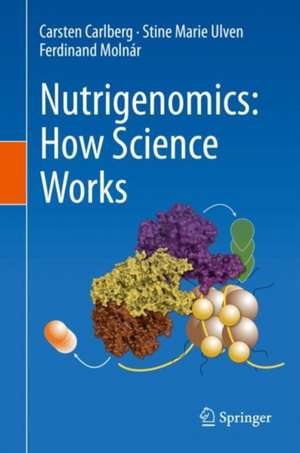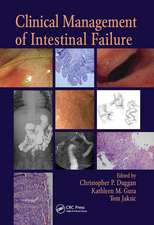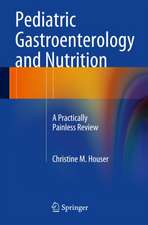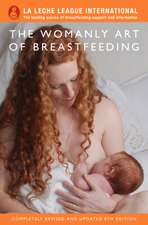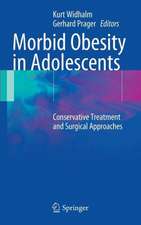Nutrigenomics: How Science Works
Autor Carsten Carlberg, Stine Marie Ulven, Ferdinand Molnáren Limba Engleză Hardback – 15 feb 2020
The purpose of this book is to provide an overview on the principles of nutrigenomics and their relation to health or disease. The content of this book is based on the lecture course “Nutrigenomics”, which is held since 2003 once per year by Prof. Carlberg at the University of Eastern Finland in Kuopio. The book represents an updated but simplified version of our textbook “Nutrigenomics” (ISBN 978-3-319-30413-7). Besides its value as a textbook, “Nutrigenomics: how science works” will be a useful reference for individuals working in biomedicine
| Toate formatele și edițiile | Preț | Express |
|---|---|---|
| Paperback (2) | 361.06 lei 3-5 săpt. | +14.93 lei 4-10 zile |
| Springer International Publishing – 23 mai 2020 | 361.06 lei 3-5 săpt. | +14.93 lei 4-10 zile |
| Springer International Publishing – 30 mai 2018 | 654.11 lei 6-8 săpt. | |
| Hardback (2) | 455.78 lei 3-5 săpt. | +24.13 lei 4-10 zile |
| Springer International Publishing – 15 feb 2020 | 455.78 lei 3-5 săpt. | +24.13 lei 4-10 zile |
| Springer International Publishing – 21 iun 2016 | 1086.15 lei 6-8 săpt. |
Preț: 455.78 lei
Preț vechi: 495.42 lei
-8% Nou
Puncte Express: 684
Preț estimativ în valută:
87.21€ • 91.06$ • 72.02£
87.21€ • 91.06$ • 72.02£
Carte disponibilă
Livrare economică 25 martie-08 aprilie
Livrare express 08-14 martie pentru 34.12 lei
Preluare comenzi: 021 569.72.76
Specificații
ISBN-13: 9783030369477
ISBN-10: 3030369471
Pagini: 181
Ilustrații: XXI, 181 p. 70 illus., 69 illus. in color.
Dimensiuni: 155 x 235 x 18 mm
Greutate: 0.48 kg
Ediția:1st ed. 2020
Editura: Springer International Publishing
Colecția Springer
Locul publicării:Cham, Switzerland
ISBN-10: 3030369471
Pagini: 181
Ilustrații: XXI, 181 p. 70 illus., 69 illus. in color.
Dimensiuni: 155 x 235 x 18 mm
Greutate: 0.48 kg
Ediția:1st ed. 2020
Editura: Springer International Publishing
Colecția Springer
Locul publicării:Cham, Switzerland
Cuprins
1.Nutrition and common diseases.- 1.1.Evolution of human nutrition.- 1.2.Principles of metabolism.- 1.3.Dietary molecules.- 1.4.Nutrition and metabolic diseases.- 1.5.Nutrition and cancer.- 1.6.Impact of physical activity.- 2.Human genomic variation.- 2.1.Migration and evolutionary challenges of Homo sapiens.- 2.2.Diversity of human populations.- 2.3.Genetic variants of the human genome.- 2.4.Haplotype blocks and GWAS.- 2.5.The 1000 Genomes Project.- 3.Sensing nutrition.- 3.1.Nutrient-sensing mechanisms.- 3.2.Nuclear receptors as nutrient sensors.- 3.3.Functions and actions of PPARs.- 3.4 Integration of lipid metabolism by LXRs and FXR.- 3.5.Coordination of the immune response by VDR.- 3.6.Circadian control of metabolic processes.- 4.Interference of the human genome with nutrients.- 4.1.Human genetic adaptions.- 4.2.Genetic adaption to dietary changes.- 4.3 Regulatory SNPs and quantitative traits.- 4.4.Nutrigenomic analysis.- 4.5 Personal omics profiles.- 5.Nutritional epigenetics.- 5.1.Epigenetic mechanisms.- 5.2.Intermediary metabolism and epigenetic signaling.- 5.3.Nutrition-triggered transgenerational epigenetic inheritance.- 5.4.Population epigenetics.- 6.Nutritional signaling and aging.- 6.1 Aging and conserved nutrient-sensing pathways.- 6.2.Neuroendocrine regulation of aging.- 6.3.Principles of insulin signaling.- 6.4.Central role of FOXO transcription factors.- 6.5.Caloric restriction from yeast to mammals.- 6.6.Cellular energy status sensing by sirtuins and AMPK.- 7.Chronic inflammation and metabolic stress.- 7.1 Central role of monocytes and macrophages.- 7.2.Acute and chronic inflammation.- 7.3.Reverse cholesterol transport and inflammation.- 7.4.Sensing metabolic stress via the ER.- 8.Obesity.- 8.1 Definition of obesity.- 8.2 Adipogenesis.- 8.3.Inflammation in adipose tissue.- 8.4.Energy homeostasis and hormonal regulation of food uptake.- 8.5.Genetics of obesity.- 9.Insulin resistance and diabetes.- 9.1.Glucose homeostasis.- 9.2.Insulin resistance in skeletal muscle and liver.- 9.3.β cell failure.- 9.4.Definition of diabetes.- 9.5.Disturbed glucose homeostasis in T2D and its treatment.- 9.6.Genetics and epigenetics of T2D.- 10.Heart disease and the metabolic syndrome.- 10.1.Hypertension.- 10.2.Mechanisms of atherosclerosis .- 10.3.Lipoproteins and dyslipidemias.- 10.4.Whole body’s perspective of the metabolic syndrome.- 10.5.Metabolic syndrome in key metabolic organs.- 10.6.Genetics and epigenetics of the metabolic syndrome.
Notă biografică
Prof. Carsten Carlberg: Professor for biochemistry at the School of Medicine, Institute of Biomedicine at the University of Eastern Finland. The main research interests of Prof. Carlberg are (epi)genomics of nuclear receptors and their ligands with special focus on vitamin D. So far he published more than 190 papers (H-index 50). Since 2003 he is lecturing yearly the course "Nutrigenomics", which is the basis of this textbook. Together with Dr. Molnár he also published the Springer textbook "Mechanisms of gene regulation".
Prof. Stine Marie Ulven: Professor at the Department of Nutrition, Institute of Basic Medical Sciences at the University of Oslo (Norway). The main research interests of Prof. Ulven are human dietary intervention studies and diet-gene interactions with particular focus on the role of dietary fat in prevention of chronic diseases. She has in total published 43 papers (H-index of 18).
Prof. Ferdinand Molnár: Associate Professor of Biology at the School of Sciences and Humanities, Department of Biology at the Nazarbayev University, Kazakhstan. The main research interests of Prof. Molnár are integrative structural biology and bioinformatics, eukaryotic transcriptional regulation in health and disease, and recombinant protein production. He has published 30 papers (H-index 19) on the molecular structure of nuclear receptor proteins and their natural and synthetic ligands. Together with Prof. Carlberg he published Springer textbooks on "Mechanisms of gene regulation”, “Nutrigenomics” and “Epigenomics”.
Prof. Stine Marie Ulven: Professor at the Department of Nutrition, Institute of Basic Medical Sciences at the University of Oslo (Norway). The main research interests of Prof. Ulven are human dietary intervention studies and diet-gene interactions with particular focus on the role of dietary fat in prevention of chronic diseases. She has in total published 43 papers (H-index of 18).
Prof. Ferdinand Molnár: Associate Professor of Biology at the School of Sciences and Humanities, Department of Biology at the Nazarbayev University, Kazakhstan. The main research interests of Prof. Molnár are integrative structural biology and bioinformatics, eukaryotic transcriptional regulation in health and disease, and recombinant protein production. He has published 30 papers (H-index 19) on the molecular structure of nuclear receptor proteins and their natural and synthetic ligands. Together with Prof. Carlberg he published Springer textbooks on "Mechanisms of gene regulation”, “Nutrigenomics” and “Epigenomics”.
Textul de pe ultima copertă
The fascinating area of Nutrigenomics describes this daily communication between our diet and our genome. This book describes how nutrition shapes human evolution and demonstrates its consequences for our susceptibility to diseases, such as diabetes and atherosclerosis. Inappropriate diet can yield stress for our cells, tissues and organs and then it is often associated with low-grade chronic inflammation. Overnutrition paired with physical inactivity leads to overweight and obesity and results in increased burden for a body that originally was adapted for a life in the savannahs of East Africa. Therefore, this textbook does not discuss a theoretical topic in science, but it talks about real life and our life-long “chat” with diet. We are all food consumers, thus each of us is concerned by the topic of this book and should be aware of its mechanisms.
The purpose of this book is to provide an overview on the principles of nutrigenomics and their relation to health or disease. The content of this book is based on the lecture course “Nutrigenomics”, which is held since 2003 once per year by Prof. Carlberg at the University of Eastern Finland in Kuopio. The book represents an updated but simplified version of our textbook “Nutrigenomics” (ISBN 978-3-319-30413-7). Besides its value as a textbook, “Nutrigenomics: how science works” will be a useful reference for individuals working in biomedicine.
Caracteristici
Written by experts with more than 15 years of lecturing experience on the topic Presents an updated and simplified view of the first textbook on nutrigenomics Includes a high figure to text ratio
